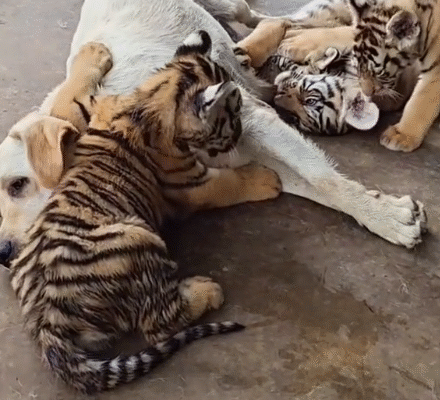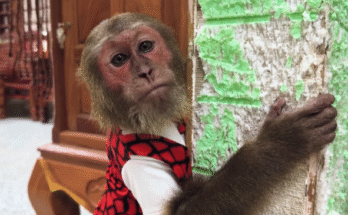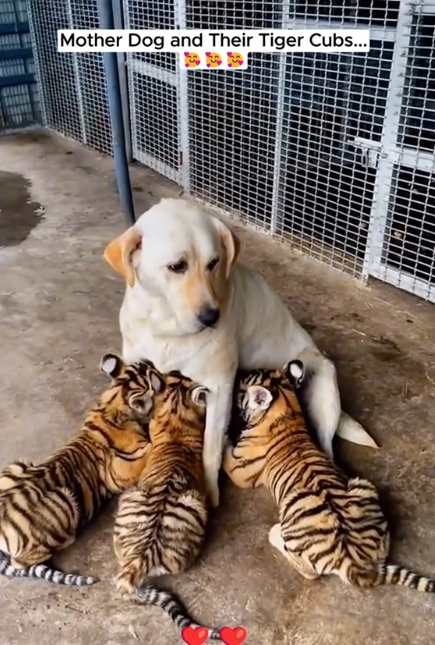
In the heart of a lush wildlife sanctuary in Southeast Asia, an extraordinary story of motherhood, love, and survival unfolded—one that left both zookeepers and visitors in awe. A mother dog named Nala, abandoned by her previous owner and rescued by sanctuary staff, became an unlikely but devoted parent to a trio of orphaned tiger cubs.
The cubs—Raja, Shira, and Batu—had lost their biological mother shortly after birth. The mother tiger had suffered complications during labor and, tragically, passed away just hours after the cubs were born. The staff at the sanctuary were devastated by the loss and concerned for the future of the newborn cubs. They needed constant warmth, care, and feeding. Artificial incubators and bottle feeding were considered, but those options lacked the vital emotional connection newborns require. That’s when Nala stepped in.
Nala, a gentle golden-brown mixed breed with soulful eyes and a heart full of affection, had been brought to the sanctuary a few weeks earlier. Although she had recently weaned a litter of her own puppies, her maternal instincts remained strong. When one of the caretakers placed a crying tiger cub near her to gauge her reaction, Nala sniffed it carefully, nudged it gently with her nose, and began licking it clean—an unmistakable sign of acceptance.
With cautious optimism, the sanctuary introduced all three tiger cubs to Nala. To everyone’s amazement, she welcomed them as if they were her own flesh and blood. She lay down patiently as the striped babies instinctively crawled toward her, nuzzling close and suckling for nourishment. Though the tiger cubs were different in scent, shape, and sound, Nala didn’t flinch. Her maternal heart knew only that these tiny creatures needed love.
From that moment on, Nala became their world. She fed them, cleaned them, and cuddled them to sleep. Despite the difference in species, the bond between Nala and the tiger cubs blossomed with undeniable warmth and trust. She would bark gently when the cubs wandered too far or whimpered for attention. When they were cold, she curled around them like a protective blanket. When they played too rough, she patiently taught them limits—just as any loving mother would.
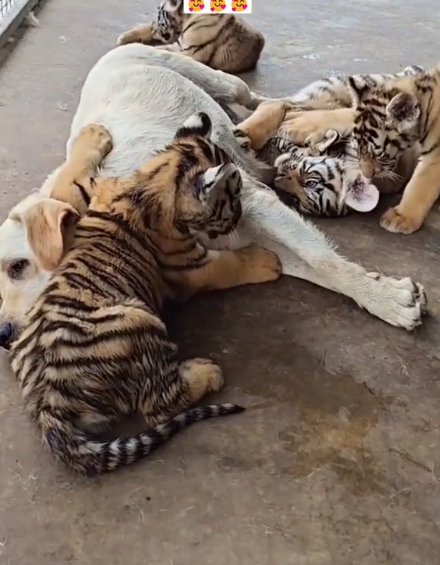
For the sanctuary staff, this was both a miracle and a challenge. As the tiger cubs grew older, their natural instincts and strength began to emerge. At three months, Raja playfully pounced on Nala’s back. Shira, always the curious one, would bite Nala’s tail and run away, only to return seconds later for cuddles. Batu, the largest of the three, developed a habit of wrestling with his “mother,” sometimes knocking her over by accident.
Still, Nala never responded with aggression or fear. She scolded them gently with a bark or a nose nudge but always forgave them with a lick or a wag of her tail. She seemed to understand that their behavior was not malicious, just natural playfulness. More importantly, she knew they were growing faster than she could keep up with. The sanctuary began planning the next phase of their care, knowing that one day, the cubs would need to transition to a more species-appropriate environment.
Visitors who heard about the story came from around the world to witness the unique family. People stood for hours, watching as a dog played the role of tiger mom with incredible patience and compassion. Children gasped in delight when the cubs followed Nala in a line like ducklings behind their mother. Photographers captured unforgettable moments: Nala licking Raja’s ear clean, Shira napping with her head resting on Nala’s belly, Batu playfully tugging at Nala’s ear while she calmly dozed off.
The story of Nala and her tiger cubs quickly went viral. News outlets picked it up, calling it “the miracle of maternal love” and “proof that motherhood knows no bounds.” Scientists praised the sanctuary’s approach and highlighted how cross-species adoption, though rare, is not impossible—especially when emotional connections are involved. Ethologists began to study the unique bond, documenting every behavioral change as the cubs grew.
By the time the cubs reached six months, it became evident that they needed more room to roam, climb, and sharpen their instincts. A new enclosure was built, complete with natural obstacles, pools for swimming, and trees for climbing. It was designed to help them prepare for a semi-wild environment while still under observation. Transitioning the cubs was gradual. At first, they were allowed to explore their new space with Nala present. But over time, the visits became shorter, until eventually, Nala would only watch from the sidelines.
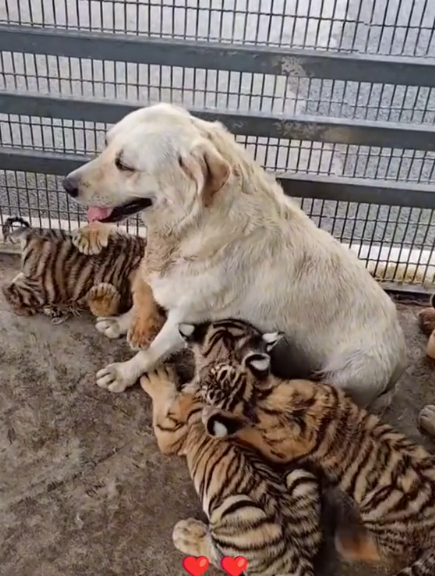
Letting go was not easy—for Nala or for the staff who had watched this unusual family grow. The day the cubs moved to their new enclosure permanently, Nala sat at the gate, ears perked, tail still, and eyes watching as her babies romped about in their new world. She didn’t bark or whimper. It was as though she understood that her job, though short-lived, was complete.
Despite no longer living together, Nala still visited the cubs from time to time, accompanied by caretakers. She would greet them with familiar sniffs and gentle nudges, and though they were much bigger now, the cubs always responded with affection. Their bond may have evolved, but it never disappeared.
Nala eventually found a new role at the sanctuary. She became a “comfort dog” for other young or injured animals brought in. Her calm presence and nurturing nature made her the perfect companion during recovery. Whether it was baby deer, injured birds, or even anxious monkeys, Nala had a gift for calming those around her. Her story continued to inspire volunteers, visitors, and animal lovers across the globe.
As for the tiger cubs, they grew into majestic, healthy adults—each with a slightly more gentle disposition than most tigers raised in captivity. Perhaps it was Nala’s influence, or perhaps it was the deep sense of safety and love they felt during their earliest days. Either way, they never forgot their first mother.
In the end, the story of Nala and her tiger cubs became a testament to the power of love beyond species, to the strength of maternal instinct, and to the unexpected ways that nature surprises us. It reminded the world that family isn’t always about blood—sometimes, it’s about the heart.
And Nala’s heart was as big and strong as any tiger’s roar.
